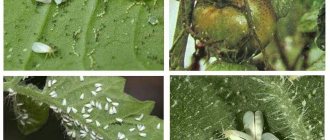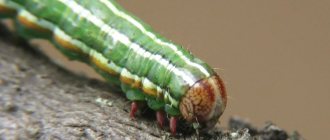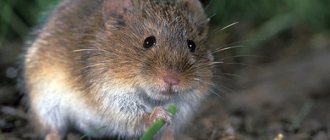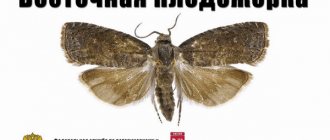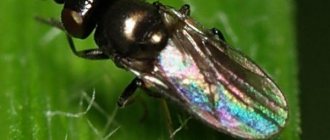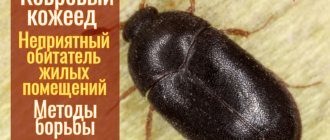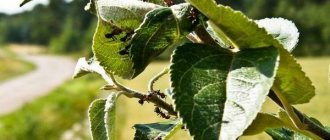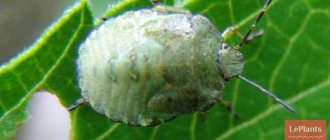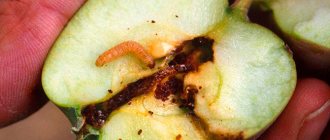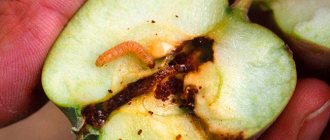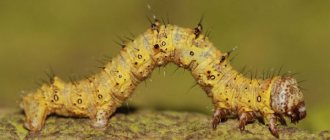Along with phylloxera, one of the most dangerous pests of grapes is the leaf roller. It is active throughout the season, damaging not only inflorescences, but also berries of varying degrees of maturity. The material describes the grape budworm and other species found in vineyards, discusses control methods, and provides a list of suitable drugs.
Leaf roller: overview characteristics and photos
Leaf rollers (Tortricidae) are a large family with more than 10 thousand species distributed throughout the world. Pests of grapes include, for example, biennial and cluster leaf rollers (see photo).
Externally, an adult butterfly is small, up to 2.5 cm or less. The wings are triangular or trapezoidal, folding like a roof. The length of the wings is 2-4 times greater than the width. They can produce 1-3 generations per year. They are active in the evening, sometimes in the morning. Many species are attracted to light.
In temperate climates, depending on the species, leafrollers overwinter at different stages of their development (eggs, adults, caterpillars or pupae). They usually rest in tree bark, soil, stems, buds, etc. During wintering, leafrollers are in a state of diapazusa and can tolerate low temperatures down to -40°C. In a hot subtropical climate, such pauses, on the contrary, occur in the summer and are associated with low humidity.
Reasons for appearance
The leaf roller appears on the apple tree and multiplies quickly if the garden is not well maintained. Weak, diseased trees are the first to be affected.
When nothing threatens or interferes with the existence of pests, they fill all suitable places. In addition to apple trees, cherries, pears, lindens and rowan trees are also at risk. If they grow nearby, leaf rollers are likely to choose this particular area.
Inaction and lack of control will lead to the spread of the pest throughout the entire area. Other plants may become infected.
Most common types
The following types of leaf rollers pose the greatest danger to grapes:
- biennial;
- bunch;
- grape
The biennial leaf roller (Eupoecilia ambiguella) is a butterfly measuring 10-12 mm. The front wings have different colors, most often yellowish. A characteristic feature is a stripe running across the wings. The eggs are transparent, with yellowish-orange spots. The caterpillars are red-brown, the head and occipital shield are dark. This type of leafroller usually produces 2 generations per year. The pest overwinters in the pupal phase. In spring, development begins at a temperature of 9-10ºС. The first year of butterflies occurs in May (when the average daily temperature is 15-16°C).
The cluster leaf roller (Lobesia botrana) is a small butterfly with a wingspan of only 10-17 mm. The variegated color of the wings contains brown, brown, and olive shades. The hind wings are gray with dark edges. The caterpillars are gray-green with a yellow head (size up to 12 mm), very mobile. The eggs are small (only 1 mm), flat, initially greenish-brown, then yellow-brown. This leaf roller overwinters in the form of a pupa. In our climate it usually produces 3 generations.
Grape leaf roller (Sparganothis pilleriana) is a dangerous grape pest. It produces only one generation per year. It overwinters at the first instar caterpillar stage. The color of the butterfly's wings is golden or ocher-yellow with two oblique brown stripes. Often the picture may be missing or appear blurry. The eggs are oval, arranged in a clutch of 50-80 pieces. First yellow-green, then orange-yellow. The caterpillar is relatively large (more than 2 mm), green with a dark brown head and prothoracic shield.
Features of development
Stages of development
Let's look at the life cycle of a pest using the grape budworm as an example. Typically, it produces three generations per year (in hot summers - 4):
- The first generation occurs during the budding phase. Spring summer lasts more than 20 days. About 10 days after the start of active summer, the leaf roller lays eggs on the grapes. Usually this stage coincides with the phase of inflorescence extension. After 6-12 days, caterpillars hatch and feed on the buds. One larva destroys up to 60 buds per day. The caterpillars complete their development at the end of the flowering phase (approximately in the first ten days of June), after which they turn into pupae. This stage of development lasts about 10 days.
- The second generation starts when new butterflies emerge from the pupae. After a couple of days, they begin to lay eggs, and after another 8-10 days, caterpillars emerge from them. This time their appearance occurs during the phase of pea peas and berry growth. The caterpillars feed on green berries, drilling a round hole in them that is visible to the naked eye. Damaged berries wrinkle, become brownish, and acquire a bluish tint. Such grapes are often affected by gray rot and other fungal diseases.
- The emergence of third generation butterflies is observed in late July - early August, when early varieties are already ripening. Care for pupation ends in October. Most of the emerging caterpillars no longer have time to pupate, and they are collected along with the harvest.
Reproduction
Butterflies of this family have sexual reproduction. Females are ready for mating already 2-3 days after emerging from the pupa. Sexual selection is carried out using pheromones secreted by males and females. A couple of days after mating, the butterflies lay eggs. For example, the grape leaf roller places them in groups of 5-175 pieces on the surface of the leaves next to the main vein. The eggs of the cluster leaf roller are located singly or in groups of several pieces on buds, inflorescences, and berries.
What harm does a butterfly cause?
The pest is widespread in all grape growing areas. The danger of leaf roller caterpillars is that they do not feed on any one crop, but are polyphagous. In conditions of poor agricultural technology, without natural enemies, they are found on grapes, fruit trees, lilacs, mountain ash, conifers, etc.
Caterpillars damage not only berries, but also inflorescences, buds, and leaves. In seasons favorable for the pest, the biennial leaf roller destroys up to 70% of grape bunches, and the cluster leaf roller destroys up to half the harvest.
Why is it dangerous?
Leafworm caterpillars harm apple trees throughout the growing season.
The first caterpillars damage flower buds , which reduces the formation of fruit ovaries. After flowering, they move to the tops of young shoots, eat and curl the apical leaves , which leads to growth retardation.
This is especially dangerous for young apple trees in which the crown is forming. In the second half of summer, the caterpillars move on to the fruits , eating holes in them.
During mass reproduction, leaf rollers move to other fruit trees and shrubs in the garden.
Treating the garden with chemicals
Only a set of measures can protect a garden from leaf rollers, including agrotechnical measures, regular treatment of the vineyard with chemicals, and the use of bioinsecticides.
Ideally, treatment should be planned based on the activity of butterflies. So, the first spraying is carried out when the first caterpillars appear (18-20 days from the beginning of the butterflies’ flight), the second - after 7-10 days, the third - when the third generation caterpillars appear.
However, not all gardeners can afford daily monitoring of the site. In such cases, regular insecticide treatments are recommended, timed to coincide with the phases of grape development:
- along the green cone;
- when 5-7 leaves appear;
- 10 days before and after flowering.
The range of drugs offered by manufacturers is wide. Here are just a few names:
| Name | Usage, per 10 liters of water | Consumption of working solution, l/bush | Waiting period, days | Number of treatments |
| Coragen | 2.5 ml | 0,5-1 | 21 | 2 |
| Tanrek | 3 ml | 0.5-1.5 (before flowering) | 7 | 1 |
| Inta-vir | 16 g | 2-5 | 20 | 1 |
| Shar Pei | 3 ml | 2-5 | 25 | 3 |
| Sumi-Alpha | 5 ml | 2-5 | 45 | 1 |
Important! When purchasing an insecticide, you should pay attention to its toxicity, waiting period, and approval for use on private farms. Treatment is carried out taking into account how likely the pest is to appear:
- if there were no leaf rollers on the site in previous seasons, the first preventive treatment is sufficient;
- if the grapes have already been affected by the leaf roller, the number of sprayings is increased.
30 days before harvest, chemical treatments are stopped and switched to bioinsecticides.
Prevention measures
As a rule, absolutely healthy and strong plants are avoided by pests. And first of all, leaf rollers settle on crops weakened by disease or improper care. Remember about the agrotechnical rules of crops, and also provide them with timely care; for this plant you need to weed, water, prune and feed on time. Make sure that the crowns of the plants are not overly thickened, and that there is a sufficient amount of nutrients and moisture in the soil, but remember that both their deficiency and excess can harm both shrubs and trees. If the tree trunk is overgrown with grass, this increases the likelihood of a leaf roller appearing. Make sure that the soil in the tree trunk circle is always loose.
In order to prevent the spread of leaf roller caterpillars throughout the garden, you need to remove fallen leaves and fruits from under the plants every day, especially if the moth has settled on them. Tree bark is cleaned in early spring, dead parts are removed, after which the surface of the trunk is covered with lime milk, which is mixed with chalk solution or copper sulfate, and Karbofos (2%) is also added to it. Try to prevent frost and mechanical damage from appearing on trees.
Preventative treatments
In order to prevent the appearance of leaf rollers in the garden, experts advise systematically carrying out treatments for preventive purposes. The plants are treated for the first time during the season in early spring, immediately after the skeletal branches and trunks of the trees have been cleaned and whitened. The treatment is carried out before sap flow begins, and the air temperature should not be lower than 10 degrees; if it is colder outside, the larvae will hide under the bark, and the drug used for spraying will not be able to act on them.
For preventive purposes, plants are treated with agents such as Kinmiks or Decis, but do not forget to follow the instructions. These products are also used for subsequent treatments, which are carried out shortly before the plants bloom and immediately after flowering. During fruit growth, fruit bushes and trees are also sprayed for preventive purposes; for this you can use Karbofos, Iskra, Kinmiks, Fury, Kemifos, Tsitkor or Decis. After this, the crops are no longer sprayed with chemicals, but it is still necessary to regularly remove loose fruits and leaves, tear off foliage from plants, and also regularly hang traps and use trapping belts to tie trees. When the leaf fall ends, clear the garden area of foliage and loosen the soil in the tree trunk circles. Then the bushes and trees, as well as the surface of the earth under them, are sprayed with copper sulfate or Bordeaux mixture.
Controlling the parasite using biological insecticides
Combating the leaf roller with the help of biological products is possible even at the berry ripening stage, since such products are considered safe for humans. Review of bioinsecticides:
| A drug | Application rate, per 10 liters of water | Consumption of working solution, l/ bush | Waiting period, days | Number of treatments |
| Fitoverm | 3 | 1 | 3 | 2 |
| Lepidocide | 20-30 ml | 2-5 (against each generation after 7-8 days) | 5 | 2 |
| Aktofit | 20 ml | n/a | 2 | 1-2 |
| Bitoxibacillin | 60-80 g | 2-5 (8-10 days after the start of butterfly summer and against each generation after 5-7 days) | 5 | 2 |
Folk recipes
To reduce the number of butterflies, and therefore reduce the number of eggs laid, homemade traps with bait are used. Between the bushes at the height of the clusters, containers with various fillers are hung:
- wine with sugar and vinegar;
- water with jam and kvass.
Grape budworm and other species end up in jars and die there. The number of leafrollers caught in traps is influenced by weather conditions: the lower the humidity, the greater the insects’ need for liquid. The catch is checked every 2-4 days, traps are changed weekly.
Symptoms of the lesion
It is very easy to detect damage on branches, shoots, fruits and leaves. Signs of damage depend on the season of the year:
- in early spring - a thin cobweb appears;
- in mid-spring - eaten shoots, buds, flowers, cobwebs;
- at the end of spring - curled leaves;
- at the beginning of summer - cocoons appear;
- in mid-summer - thick cobwebs and increased activity of butterflies;
- at the end of summer - green shoots with dark spots;
- in autumn - a large number of twisted leaves, fruits in a web.
Treatment times and preventive measures
You can achieve the maximum effect from the drugs used if you correctly guess the timing of the treatments. Every year, butterflies develop at different times depending on temperature and humidity, so there are no specific dates for spraying. Gardeners are advised to focus on the phases of grape development and carry out the first preventive treatments at the beginning of bud break.
Another effective method that determines the period for using insecticides is the so-called pheromone traps. They attract males and, by the number of “catch”, let winegrowers know about the beginning of the summer of butterflies. Every morning the traps are inspected and the number of specimens caught is counted. If more than 5-8 butterflies are caught within 3 days, the third day is set as the beginning of sustainable summer. Massive years begin in 8-10 days.
Along with the use of various drugs in the fight against leaf rollers, not the least place is given to agrotechnical measures:
- garter shoots;
- stepsoning;
- thinning pruning;
- weed control;
- destruction of damaged bunches.
How to properly spray apple trees after flowering
Whether you are going to treat apple trees with Bordeaux mixture, urea, or have found another effective remedy for ridding trees of pests in the spring, in any case you need to know how to spray correctly. First of all, prepare the selected liquid (already dissolved in water), the apparatus for performing the procedure (pump) and the appropriate protective equipment (mask, gloves and goggles).
Spraying columnar apple trees is easiest: all you have to do in this case is walk around the plant several times and spray the fungicide over its entire surface. There is no need to look for a ladder and twist to reach an inconveniently growing branch.
It is important to spray the solution completely over the entire surface of the plant, starting from the stem and ending with the very top (try not to miss a single branch). In the case where an old apple tree was chosen for the experiment, you will ultimately get one of two possible results: either the damaged part of the plant will no longer be able to recover, or the chemical agent will not be able to greatly harm the “thick-skinned” tree (however, it will later damage all young plants that will fall on in a few days)
In the case where an old apple tree was chosen for the experiment, you will ultimately get one of two possible results: either the damaged part of the plant will no longer be able to recover, or the chemical agent will not be able to greatly harm the “thick-skinned” tree (however, it will later damage all young plants that will fall on in a few days).
However, no matter what you decide to spray your apple trees with in the spring, in any case you should not forget about the purpose for which this is being done. If traces of the vital activity of insect pests or diseases are clearly visible on the plants, then the use of chemicals will be completely justified, but if no signs of attack by aphids, leaf rollers or other uninvited guests are found during inspection, then when caring for an apple tree in the spring you can do without fighting pests. Nevertheless, you shouldn’t completely forget about prevention, because it can save you from the invasion of harmful insects, creating excellent conditions for the full development of apple trees in the garden.
First stage
The first stage of spraying, as a rule, occurs in the second half of March. Its main goal is to destroy existing insects and prevent dangerous diseases. Before the buds begin to swell, it is recommended to spray with insecticides and fungicides.
Before starting spraying, it is necessary to trim the crown of the apple tree, remove old bark from the trunk, and also remove last year’s foliage, if this has not been done previously.
Second phase
The second treatment should occur at the beginning of the growing season. It usually starts in early April. This stage involves the destruction of pests that have awakened after winter: aphids, copperheads, scale insects and many others.
It is equally important at this stage to carry out treatment against fruit rot and scab, as the most common and dangerous diseases of the apple tree.
Third stage
This stage should occur at the end of flowering. With the right selection of drugs, you can effectively get rid of moths, ticks, caterpillars, weevils and other insects.
Also, treatment after flowering will eliminate existing diseases at the initial stage. During flowering, any processing is prohibited! At this time, you can focus your energy on loosening the soil around the tree, as well as removing weeds.
